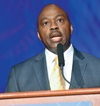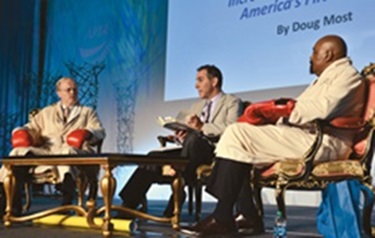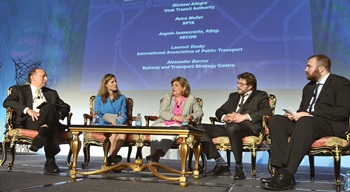 |
2015 RAIL CONFERENCE |
|
 |
| CLASSIFIEDS |
| » The Capital District Transportation Authority, Albany, NY, has an opening for a director of transportation. [More] |
| » Metra, Chicago, IL. is looking for a chief human resources officer. [More] |
| » Ben Franklin Transit, Richland, WA, seeks proposals for a comprehensive service plan study. [More] |
| View more Classified Ads » |
| TO PLACE AN AD: E-mail the requested date(s) of publication to: ptads@apta.com. Mailing address is: Passenger Transport, 1666 K Street, NW, Washington, DC 20006.
Ad copy is not accepted by phone. DEADLINE: 3 p.m. EST, Friday, one week prior to publication date. INFORMATION: Phone (202) 496-4877. |
Industry Leaders Gather for Annual Rail Conference
More than 1,200 passenger rail professionals gathered in Salt Lake City June 21-24 to network, share best practices, discuss trends and innovations, learn about industry products and services and engage in pressing industry issues as APTA conducted its International Rail Rodeo and Annual Rail Conference.
“Salt Lake is a true public transportation success story and APTA is grateful to the Utah Transit Authority (UTA) and CEO Mike Allegra for making us feel like hometown neighbors this week,” APTA President & CEO Michael Melaniphy said at the Opening General Session.
“This event is one of APTA’s largest. For the next three days, prepare to be impressed. We have designed a program to deliver the timeliest information on such issues as operations, safety and security, finance, capital projects, and advances in technology across every rail mode.”
In addition to the more than 40 focused sessions in six tracks of study, numerous technical forums, committee meetings, awards presentations and workshops were four General Sessions that featured advocacy updates, safety and security awards presentations, DOT news, a discussion of international funding and financing mechanisms and a special presentation about the race between New York City and Boston for the nation’s first subway.
Brief reports of those General Sessions start below. Find more conference news and photos in this issue.
 Washington: SU4T’s Action and Impact Washington: SU4T’s Action and Impact
At the June 22 Opening General Session, APTA Chair Phillip Washington, chief executive officer of Los Angeles Metro, praised the “big noise” the public transportation industry and its supporters made on Stand Up for Transportation Day (SU4T), April 9, and in its aftermath.
SU4T was one of Washington’s signature projects as APTA chair and, he said, “it linked two of my favorite things—action and impact.” More than 360 entities from across the U.S. participated in more than 150 events based on the need to work together in the best interest of the country to repair, strengthen and build its transportation infrastructure.
As for impact, Washington pointed out that six governors, one former governor, nine members of the U.S. Senate, 50 members of the House and 71 mayors participated in SU4T events, as did FTA Acting Administrator Therese McMillan and numerous state DOT leaders. More than 22,000 advocates representing every single congressional district signed APTA’s online petition. And in addition to extensive media coverage, SU4T was the third highest U.S. trending topic on Twitter that day.
However, Washington emphasized, the push for a long-term bill continues. “Too many of us are operating 21st-century vehicles on 19th-century infrastructure,” he said. While the primary benefit of long-term federal funding is to allow transit systems to make plans, another is that federal support helps balance the risk undertaken by private-sector partners.
He cited APTA statistics showing that eliminating federal funds for public transportation would shrink the entire economy by $227 billion—leading to a 43 percent cut in agencies’ capital budgets. Long-term, fully funded federal support for transportation, he said, is “a matter of economic prosperity, of national security, of nation building right here at home.”
Melaniphy described the “resurgence, revitalization, and renaissance in rail” spreading across the U.S. in recent years. He called the various forms of passenger rail “a mode of mobility that has always connected our country.”
He also addressed rail’s present-day impact. “A new kind of national mobility grid is emerging and it is being driven by rail. We are literally changing America.”
Melaniphy cited the opening of 190 new U.S. rail projects since 1990, many of them within the past 18 months. “Even as we sit here today, more than 2,500 miles of high-performance rail are under construction in 34 states,” he added.
For example, he noted the accomplishments of UTA, host system for the conference. After starting from scratch, UTA now provides service on more than 135 miles of passenger rail, including commuter rail, light rail and streetcars.
Echoing Washington’s call to action, he stressed, “There are no short-term solutions to our long-term challenges. We need Congress to understand that this is the time to make the necessary investments: for public safety, for growing demands, for increased capacity and for the prosperity of our nation”—harkening back to the completion of the first Transcontinental Railroad at Utah’s Promontory Point in 1869.
Melaniphy also listed an “ongoing and absolute commitment to safety,” including education of passengers, and the need to keep up with new technologies as priorities for rail transit professionals.
Utah Gov. Gary Herbert welcomed conference attendees, calling himself a “common-sense conservative” who believes that the importance of transportation to a community must trump rigid ideologies. Businesses considering investing in Utah understand, he said, that “if you want to prosper in this state, we need a transportation system that works.”
Salt Lake City Mayor Ralph Becker praised UTA’s “incredible return on investment,” saying that the city’s population growth would not have been possible without public transit. “We know that rail is part of the future of Salt Lake City and is important to preserve what we love about living here,” he added.
Greg Hughes, speaker of the Utah House of Representatives and a former UTA board member, told of how he began as a “bitter critic” of public transportation in a spread-out community—he came to Salt Lake City from Pittsburgh—and how his attitudes changed as he saw how different modes and technologies can serve communities. “I believe transportation infrastructure is a responsibility of government,” he said. “It doesn’t have to be a partisan issue; we can find common ground.”
Allegra thanked the business community for its “unbelievable support” during the FrontLines 2015 effort, which completed five rail projects under budget and two years ahead of schedule.
The session opened with a fast-paced video presenting the history of passenger rail, from the driving of the Golden Spike in Utah in 1869 to complete the first Transcontinental Railroad to present-day images of UTA’s TRAX light rail, FrontRunner commuter rail and the Sugar House Streetcar. See the one-minute video at http://APTA.vzaar.me/4330373.
HDR sponsored the Opening General Session.
Feinberg, McMillan at DOT Session: Dealing with Safety, Other Challenges
Safety was the main issue in a discussion with FRA Acting Administrator Sarah Feinberg and FTA Acting Administrator Therese McMillan at the Monday afternoon “Dialogue with USDOT” session, hosted by APTA Chair Phillip Washington.
 Feinberg participated via teleconference because she was preparing to testify on PTC at a June 24 hearing before the House Transportation and Infrastructure Subcommittee on Railroads, Pipelines and Hazardous Materials. (See related story on page 3.) Feinberg participated via teleconference because she was preparing to testify on PTC at a June 24 hearing before the House Transportation and Infrastructure Subcommittee on Railroads, Pipelines and Hazardous Materials. (See related story on page 3.)
“Safety rules everything we do at FRA. We need to ensure that we are doing everything we can to make your jobs easier,” Feinberg said. She added that “Few organizations do as much as APTA does to make our systems increasingly safe,” noting that APTA is an important part of the nationwide debate about safety and resources.
Feinberg called PTC “the most important safety technology in more than a century” and said FRA stands behind the congressional requirement for rail systems to implement PTC by the end of this year. “I know that decision gives many of you significant heartburn and that the process is expensive,” Feinberg said. “To reach full implementation, Congress and FRA must partner with your agencies.”
McMillan said, regarding safety and state of good repair issues, “Transit systems do not have the luxury to choose between adding capacity and maintaining safety. They need to do both and need funding that will allow this to happen.”
She commented on FTA’s Safety Management Inspection of the Washington Metropolitan Area Transit Authority following the smoke incident in January that led to the death of one passenger. FTA gained oversight authority as part of MAP-21, she said, and the process must take into account the specific needs of each agency rather than trying to use a single format for all systems.
She related her travel experience attempting to fly from Washington to Salt Lake City for the conference as an example of “the reality we need to strive for in public transit.” The plane left the gate and sat on the tarmac because of incoming bad weather, she said, then returned to the gate to get additional fuel to accommodate a longer alternative route. The fueling took long enough that the time window for departure closed, leading to the cancellation of the flight after five hours.
“The passengers in our full plane, a Boeing 757, were annoyed by the inconvenience,” she said, “but they weren’t crazed; there were no screaming calls for the pilot’s head. At the end of the day, we knew those decisions were made to keep us safe as passengers and to keep that flight crew safe. We accepted that; we knew that’s what had to be done.”
 McMillan also spoke about transportation as “a huge catalyst for economic development,” citing major public transit projects in cities including New York, Washington, Boston and Los Angeles. McMillan also spoke about transportation as “a huge catalyst for economic development,” citing major public transit projects in cities including New York, Washington, Boston and Los Angeles.
“In these cities and so many others, public transit connects people to jobs, education and the many opportunities the communities present,” she said. “In continuing to do that, transit agencies have to imagine and plan forward-looking projects, which is difficult with the uncertainty we all face at the federal level.”
She noted her participation in a Stand Up 4 Transportation event in Philadelphia, saying, “Your voices were heard. Your continued advocacy work is indispensable and cannot stop” without an authorization bill in place beyond the end of July. She reiterated the importance of the administration’s GROW AMERICA Act proposal, which would increase public transit spending by 76 percent above Fiscal Year 2015 levels. “That level of commitment, or something close to it, will help us meet demand while closing the current funding gap for system repairs and replacements.”
 Luncheon General Session: Boston vs. New York for Nation’s First Subway Luncheon General Session: Boston vs. New York for Nation’s First Subway
When Bob Prince and Chris Boylan took the stage during the Luncheon General Session to talk about The Race Underground, a new book on the rivalry between Boston and New York City to build America’s first subway, they brought their knowledge of the cities’ systems today and how each could increase and improve services—if, they said, there was enough money.
But first, it’s important to note, both were wearing robes over their suits and bright red boxing gloves, doing a little faux sparring in front of host Doug Most, author of The Race Underground.
“Pity the fool,” Prince snapped at Boylan, and the audience roared with laughter.
Boylan, representing New York City, is a member-at-large of the APTA Executive Committee and director of government and strategic partnerships at the General Contractors Association of New York. He formerly worked at the New York Metropolitan Transportation Authority.
Prince, representing Boston, is a vice president of AECOM and a former general manager of the Massachusetts Bay Transportation Authority.
Most, a journalist who has lived in New York and now Boston, has written the history of the building of both subway systems and acknowledges a fascination with the subject.
“It’s easy to forget how much people love and appreciate what public transit does for them. To imagine life without it is impossible.”
The Race Underground carefully details the work of inventors such as Thomas Edison; Frank Sprague, who created the electric motor that one day would power subway cars; William Barclay Parsons, the engineer behind New York’s subway; and others who spent years, fortunes and sometimes their lives to get the trains safely on the track.
Today, Prince and Boylan agreed, the issue is money—and dreams. So what, Most asked, would these dream projects look like?
“I’d like to see the Northeast Corridor done,” Prince said. “High-speed rail to get those people to Boston quicker.”
Most also asked them about the progress that has been made and what should be done in the future.
Prince said Boston trains its firefighters, police and EMTs on actual equipment, so the city took over an old tunnel and built the facility to do so.
“We don’t forget how important safety is in our industry,” he said. “Somebody makes a mistake and you won’t be home for dinner.”
Boylan, citing Most’s book, said New York has a number of “doers. In my limited knowledge of history, I thought it was one or two people that built the New York subway.” Instead, there were countless “doers who didn’t let the obstacles get in their way, who just kept on rolling.”
Added Prince, “In the transit industry, look at the men and women who bring service every day, despite the lack of funding for repairs. They’re under the gun 24/7. It’s a lot of pressure. I salute them.”
Most also asked about the effects of weather on cities. The book references a 1888 blizzard that killed hundreds of people on the East Coast. It was the worst natural disaster in American history at that time and it prompted city officials to recalibrate everything, including the advantages of building an underground subway.
For Boston, last winter’s blizzards “shut down the system,” Prince said. “In four days, we were running again. You can’t stop.” For New York, it was Hurricane Sandy, which swept up the East Coast in 2012.
So, Most asked, what’s up now?
Both Prince and Boylan said sharing ideas with other professionals can be tough. Prince added that public transit officials “lose a lot” when travel to conferences and other systems is curtailed.
“We don’t do enough of that. Politics are in the way,” Boylan said.
Finally, Most added a baseball-trivia postscript. On Nov. 23, 1894, the Boston Beaneaters beat the New York Giants in Boston. The following day, voters passed a referendum to build the subway.
Two years later, on Sept. 1, 1897, the subway was finished. New York’s subway opened on Oct. 27, 1904.
AECOM sponsored the luncheon.
Applying International Best Practices
Benchmarking successful funding and financing mechanisms and international best practices that can be applied to U.S. public transit systems were at the center of discussions at the Closing General Session.
Michael A. Allegra, member, APTA Executive Committee, and president/CEO, Utah Transit Authority, and APTA Chief of Staff Petra Mollet moderated the session.
Mollet discussed APTA’s robust international program, particularly the first week-long study mission attended by 15 members from small, medium and large public transit systems. The delegation recently visited London, Stockholm and Munich to meet with city and regional representatives, public transit professionals, elected leaders and real estate developers. (See Passenger Transport, June 15, for details.)
AECOM Vice President Angela Iannuzziello, member, APTA Executive Committee, and immediate past chair, Business Member Board of Governors, led the delegation. She noted that benchmarking funding and financing plans was a large part of the mission, which she said had “unprecedented value” to participants.
“Benchmarking successful funding and financing mechanisms and how they are transferrable to the North American market were the topics of the agenda of the mission. The focus,” she added, was “to identify the cultural, political and structural factors that would impact how applicable these were to the North American public transit agencies.” What they learned, she said, was that “we are all facing very similar transit development issues and there are many tools available to us.”
Laurent Dauby, director of knowledge and membership services department, UITP (International Association of Public Transport) in Belgium, spoke about his organization’s initiative with the goal of doubling transit market share by 2025.
Launched in 2009, the initiative is aimed at energizing the sector around one strategic horizon. “It’s good for the planet, people and productivity.” Investment in public transportation “is not cheap but the cost of no transit in not an option,” he said.
Alexander Barron, associate director and metro benchmarking manager, Railway and Transport Strategy Centre, London, said the more than 70 transit operators in his benchmarking group spend $60 billion annually on operations, “largely using scarce public funds.”
He encouraged public transit agencies to be open to new ideas and to look at what has worked and has not worked. “You can’t manage what you can’t measure,” he said.
|
 |
|
UTA's Michael A. Allegra; Petra Mollet, APTA chief of staff; Angela Iannuzziello, AECOM vice president, Canada; Laurent Dauby, UITP, Belgium; and Alexander Barron, Railway and Transport Strategy Centre, London, discuss international best practices. |
|